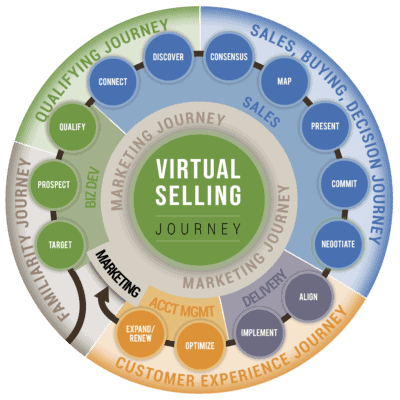
Accelerating the Adoption of Virtual Selling Skills in Field Sales
To remain relevant and productive field sales professionals must adopt virtual selling skills now. The fact is that virtual selling is here to stay and there is no going back.
A global pandemic. Panic. Social distancing. Selling from home (SFH).
In a heartbeat, we went from happy hours to virtual happy hours, conferences to virtual conferences, the classroom to the virtual classroom, selling to virtual selling.
The global coronavirus pandemic of 2020 accelerated the adoption of virtual selling much like the global financial crisis of 2007-2009 accelerated the emergence of inside sales teams and the division of sales labor into business development, selling, account management, and customer success (land, expand, and retain).
Necessity is the Mother of Virtual Selling
Except that this was faster, compressing what might have taken ten years to fully actualize into a matter of months.
In an instant, to remain relevant and competitive, field sales professionals had to shift the way they were engaging prospects and customers.
The evolution of virtual selling technology finally met its moment. Digital transformation, which for the past twenty years had been an inevitable yet slowly building tide, rolled over us like a tidal wave. Suddenly, virtual selling became king.
Unlike so many other pivotal points in history, in which smart people were forced, out of necessity, to invent technology in order to meet the moment, this time the technology was ahead of us. We simply needed to catch up.
This is where we find ourselves. Virtual selling is the new normal. There is no turning back.
It is Natural to Fear Virtual Selling
However, if your primary go-to market sales communication channel has been face-to-face, it’s natural to fear that you won’t be able to communicate effectively, build relationships, be as competitive, or make the same impact through virtual channels.
You fear that virtual selling will lower your probability of closing sales.
This fear is not unfounded. The most effective way to build relationships and trust, resolve conflict, brainstorm ideas, gain consensus, present ideas, negotiate and close deals is a physical face-to-face meeting. You know this, and I know this, because we are human.
The Field Sales Face to Face Selling Advantage
Successful face-to-face sales pros are masters at reading other people, responding to nuance, and using charisma as a competitive advantage. They have the ability to intuitively sense the emotions of other people and respond appropriately.
This is why so many field sales professionals were paralyzed with fear when the coronavirus pandemic made face-to-face interaction impossible. It was as if their sense of sight had suddenly been taken away. And, in reality, it had been.
The eyes manage roughly 80 percent of the information and communication you take in. Visual interpretation of the world and people around you consumes at least 50 percent of your brain’s computing power. In fact, a far larger part of the brain is dedicated to vision than to hearing, taste, touch, and smell combined.
When you are on face-to-face sales calls, you can see and interpret the entire picture. You see not only the person you are meeting with, but also their surroundings and how they interact with their environment.
You also have the luxury of reading their eyes, the micro-expressions on their face and the entirety of their body language. If there are other people in the room, you’re able to read their reactions and nonverbal signals as well.
The Power of Emotional Contagion
Emotional contagion is another form of sight that is significantly diminished in quality and clarity when you are communicating through virtual channels versus face-to-face.
Emotional contagion is a subconscious response that allows us to pick up on the emotions of other humans without much conscious effort. Like invisible vibrations, emotions are easily transferred from one person to the other when we are together.
We are constantly scanning those around us for clues about their emotional state. We read between the lines, interpret those clues, and alter our approach to people based on our perceptions.
Though you can see the other person on a video call or hear their voice over the phone, it is not the same as being in person. It’s cloudy, and never as clear as when you are selling face-to-face.
When you are face-to-face with prospects and customers, it is easier to:
- Ask for the next step—and know when to ask for the next step.
- Tour facilities, get hands-on and understand their real issues and problems.
- Communicate clearly and minimize miscommunication.
- Know when what you are saying or presenting is off-base or missing the mark.
- Accurately read stakeholders and develop discovery questions organically, in the moment.
- Compare the words that stakeholders say with their nonverbal communication for congruency.
- Keep people engaged, because it is far less likely that they’ll drift into social media, look at their email, or become distracted when you are sitting in front of them.
- Build relationships.
- Gain commitments. It is much harder for stakeholders to say no to your face.
Face-to-face human interaction is powerful, persuasive, and compelling. When you are there, face-to-face, it sends the message that the meeting is important, and it makes the person with whom you are meeting feel important. It demonstrates your credibility and allows you to fully leverage your personal brand.
Because face-to-face meetings require both parties to make a significant investment of time, it increases the probability that there will be meaningful outcomes and that your deal will move to the next step. All of this and more is why face-to-face selling and human interaction is going nowhere.
You’ve Already Adopted Virtual Selling Tool
So, there you have it. We’ve made a heck of a case for Face to Face selling. Yet, despite the indisputable case, if you fail to rapidly adopt virtual selling skills, you will quickly find yourself obsolete.
Still, when salespeople or leaders hear the word virtual paired with the word selling, it’s natural for many to think “robots.” They envision sales activity devoid of any human-to-human contact.
This, of course, makes sales professionals who make their living through face-to-face selling recoil. Face-to-face is their comfort zone and their skill set. It’s difficult to conceive that it’s possible to sell any other way and why they should adopt virtual selling skills.
Yet, virtual selling is simply leveraging virtual communication channels in place of physical, face-to-face interaction.
Virtual communication channels include:
- Video Conferencing
- Video Messaging
- Telephone
- Interactive Chat
- Text Messaging
- Voicemail and Audio Messaging
- Social Media
- Direct Messaging
- Snail Mail
If you look closely at the list above, you’ll notice that you are already using some, if not all, of these channels. You are already engaging in some level of virtual selling activity.
You’ll also notice that all of the tools and technology that you need to engage in virtual selling—communicating with prospects and customers without physically being there—already exist.
The Virtual Selling and Virtual Buying Journeys
Therefore, since every salesperson is engaging in some level of virtual selling, this is not a showdown between virtual selling and face-to-face selling.
It is not about “revolutionizing” the way you sell.
Rather, it’s a laser focus on applying virtual selling tools more effectively to engage and connect with other humans while boosting your sales productivity. It’s about helping you improve your virtual communication along the three main journeys of the sales continuum:
- Business development: Engaging prospects and moving them into the pipeline (targeting, qualifying, engagement)
- Selling: Advancing opportunities through the pipeline (initial meetings, discovery, demos, presentations, negotiating, closing)
- Account management: Expanding and growing existing accounts (onboarding new customers, delivering products and services, up-selling, cross-selling, developing relationships, adding new products and services, retention)

Virtual Selling is Human to Human
From the beginning of human self-awareness, we have been driven to develop virtual communication tools, techniques, methodologies and technologies to facilitate human-to-human connection when we are far apart.
The digital transformation of the 21st century has aimed to break down barriers to human-to-human connection while removing inefficiencies that slow down the pace of communication. Today, we have the capacity to interact with and engage people across the globe at breakneck speed.
The tools have changed. What has not changed, since the dawn of mankind, is the innate human craving for emotional connection.
When You Adopt of Virtual Selling You Must Make a Mindset Shift
In the virtual world, though, everything moves fast. I don’t want to discount just how challenging virtual selling can be. It requires constantly learning, adopting and adapting to new technology. At the same time sales professionals must practice and hone the interpersonal skills required to build relationships and influence others.
Adopting virtual selling skills requires a mindset shift. You must:
- Apply interpersonal skills in new ways
- Learn how to influence and persuade without the help of some of your senses
- Move at a faster pace
- Get out of your comfort zone
With this new mindset, however, you’ll quickly build a more robust pipeline, increase sales productivity, and close deals faster.
Sales Gravy’s Virtual Selling Skills Master Class gives your sellers the tactics, techniques, and strategies for leveraging video-based technology and virtual communication to engage remote buyers.
About the author
Jeb Blount
Jeb Blount is one of the most sought-after and transformative speakers in the world…
Get FREE Sales Training Delivered to Your Inbox
Join more than 360,000 professionals who get our weekly newsletter.
Related Articles

Learn Online
Self-paced courses from the
world's top sales experts

Virtual Training
Live, interactive instruction in small
groups with master trainers

Coaching
One-to-one personalized coaching
focused on your unique situation






